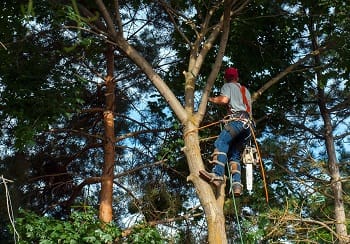
Tree care workers and landscapers make up just a small percentage of the national workforce but a significant percentage of workplace fatalities. If you are a part of this industry in Minnesota, you will likely know that you risk your life every day and that you must take certain precautions to stay safe. Safety authorities say that most of the fatalities in this industry occur during tree trimming and tree removal.
Employers in this industry are responsible for the safety of employees, and the best way to do this is to establish and implement a comprehensive safety program that includes safe procedures and written rules. However, you might have to take your own precautions, such as inspecting trees before you climb or cut them to identify structural weaknesses and dead limbs. Using safe procedures can prevent the accidental cutting of lanyards, climbing ropes, straps or safety belts.
Electrocution hazards
Branches and limbs of trees, uninsulated aerial lifts and other objects touching overhead power lines can cause electrocution. Staying alert and treating all electrical cables as live and energized is crucial. The following precautions are essential:
- Make sure you wear appropriate personal protective equipment.
- Avoid trimming trees in adverse weather conditions.
- Keep electric power tools away from trees that are close to power lines.
- Use only ladders made of wood or synthetics rather than metal or other conductive materials.
Aerial lift hazards
Falls, tipovers, collapsing equipment and electrocutions can cause fatal injuries to tree workers. You should treat these machines with the necessary care and follow these rules:
- Do not operate an aerial lift if you are not a qualified operator, and when you are in the bucket, wear a body harness and attach the lanyard securely to the bucket. Also, wear a hard hat and eye protection.
- To avoid tipovers, you can inspect the lift before use and ensure it stands firmly on a solid surface. Set the brakes and use wheel chocks.
- Avoid overreaching beyond the bucket’s edge to prevent falls.
Wood chipper hazards
Wood chippers have claimed many limbs and lives, and you should always ensure that the safeguards are in place and that emergency shutoff devices and controls are in proper working order. The following precautions can help prevent the chipper from pulling you in:
- Wear head, ear and eye protection and make sure your clothes are not loose fitting, and avoid wearing gloves with cuffs that could catch on the working parts of the chipper.
- Follow the instructions of the manufacturer at all times, and stand to the side while feeding branches into the machine. Use larger branches to push smaller ones into the chipper, rather than using your hands, and never try to unjam the machine without cutting the power.
- Make sure that no lines or ropes are close to the chipper.
Roadside tree work poses another set of hazards to workers and passersby, and you must establish safe drop zones and have a safety plan in place for traffic control in the area.
Tree work presents many more risks, many of which might be unanticipated. If you suffer a work-related injury, you might be unsure of how to cope with the mounting medical bills and wage losses and where to look for help. Your best bet might be to consult with an experienced Minnesota workers’ compensation attorney who can assist with the navigation of benefits claims.

